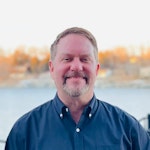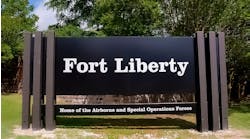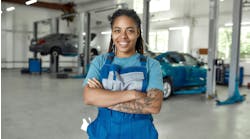With today’s increased vehicle complexity, can a collision repair shop successfully juggle the at-odds requirements of direct repair programs (DRPs) and performing repairs following OEM procedures and remain profitable? For the two collision repair shop managers FenderBender interviewed for this article, the answer was no. Each of them related their efforts to modify standard DRP agreements to allow for the simultaneous goals of proper repairs, profitability and pleasing DRP managers. They found the path to being DRP-free is not without its own struggles. But by concentrating on OEM certification programs and satisfying their customers, they’re driving profitable “walk-in” business. The payoff has been less stress, greater technician satisfaction, and increased profitability – even with a lower car count. That said, they can be an effective method of increasing car count and creating satisfied customers – if you understand their limitations.
Mohawk Collision Center in Schenectady, New York, serves Mohawk Chevrolet and Mohawk Honda, has 20 OEM certifications, and has been DRP-free for five or six years, says General Manager Gerry Rosenbarker.
“Back then, to do a $500,000 month, I used to have to process somewhere around 180 cars a month, which is exhausting,” he says. “Now we do $700,000 months with 100 cars a month.”
Josh Piccione is general manager of Tom Wood Collision Center in Indianapolis, which serves the dealership group’s 21 brands with OEM certifications for each brand. He’s been in his current position for about a year, but when he arrived at the shop 10 years ago it had a handful of small DRPs.
“We had a single DRP for about the last four or so years, and recently we decided to split paths,” he says, noting the DRP model, focused on volume and meeting certain concessions, is incompatible with Piccione’s goals for the dealership.
“A lot of these DRP agreements come with a laundry list of things that you can't do and a laundry list of things that they expect you to do a little differently. And maybe I'm just a young rookie GM and I don't yet fully understand this, but it's hard for me to understand why you would allow another company to make business decisions on your behalf.”
Leveraging OEM Certifications
OEM certifications are “raising the bar for accountability” in the collision repair industry for how repairs are to be performed, Piccione says.
“Something we take a lot of pride in here is we are very decorated when it comes to OEM certifications, and we want to fix the cars the right way,” Piccione says. “And when we started a discussion with our most recent DRP and the whys behind we were going in different directions, what I took away from it is that it's still just a volume and a metrics aspect on the DRP side.”
Outside a DRP relationship, the certifications provide more leverage in being appropriately compensated for the thorough repair plans required to follow OEM repair procedures.
“Most of the time, we have no issue when it comes to negotiating with the insurers for what needs to be done,” Rosenbarker says. “There are times they draw a line in the sand and the customer does have to participate. It's not that often, though.”
The certifications are “a badge of honor” in the company’s advertising, Rosenbarker says, and used to sell a customer on the difference between his and other shops.
“What we often say is that anybody can make the paint shiny. There are a lot of shops out there that can do a small job and make it 100%. But you bought a five-star-rated vehicle. I know I can guarantee when it leaves here, it'll be a five-star rated vehicle again. But we're going to do it by the book, because the engineers built and designed your vehicle for crashworthiness, and that's what they say needs to be done.”
Generating Early Word-of-mouth Through DRPs
Early on, the DRP agreements did serve a purpose for the shops, though. Rosenbarker’s original shop was at the Honda dealership’s old location, small and dated and not in a desirable part of town. By stationing an estimator there, customers could drop off and pick up their vehicles at the new dealership. The shop had a staff of only four at the time, doing about $45,000 to $50,000 in monthly sales. Needing to take out the peaks and valleys of the business, Rosenbarker began a DRP agreement with State Farm. Cars began to flow in. Staff worked hard to meet key performance indicators on the scorecard. With the advent of OEM certifications, he says, it was a no-brainer to try to add a Honda certification, but the old facility was a roadblock. So, he forged ahead with the DRP model, increasing the business to 13 employees and doing about $200,000 a month in sales.
With the shop bursting at the seams, the company’s owner asked Rosenbarker to help design what he’d need in a new shop. They bought property near the dealership and built a nearly 24,000-square-foot facility about nine years ago with an efficient horseshoe-shaped production flow.
Rosenbarker knew even then that OEM certifications were desirable, but his participation in the Axalta 20 group, which at the time was administered by Collision Advice’s Mike Anderson, opened his eyes to how OEM certification programs provided a path away from the DRP model.
“Like anybody else, I didn't like having the thumb of the DRP on me all the time,” he says. “Everything had to be cheaper, better, and faster, and with those pressures all the time.”
The new facility was running smoothly.
“But it’s a big facility with a lot of equipment, with three frame machines, two booths, and four prep decks. That's a big monthly nut you’ve got to make.”
The “beautiful, state-of-the-art facility” caused more work to flow from State Farm, followed by a smaller DRP, Honda certification, and certification for the brands served by Assured Performance.
The DRP agreements meant the shop often performed procedures for which it was uncompensated. But for the few years the shop was on the programs, he found that doing the repairs by the book did pay off in the form of referrals.
“These customers are very happy; they are giving us great Google reviews and telling their aunts their brothers or sisters what a great experience they had. Boom, those cars land in our shop, and most of those are not DRP, so it was working out well. We had a good rapport with State Farm and with a lot of their agents and so on.”
In examining the numbers, Rosenbarker determined the DRP agreements were not very profitable. Worse, profitable walk-in customers were not prioritized.
“We had started concentrating on the trap that I think so many shops get caught in, and that's the insurance company being your customer, rather than our own customers who maybe weren’t one of our DRP's and who chose us. So all those referrals I was working hard to get, unfortunately, I found that we were putting them on the back burner because we had to hurry up and get all the DRP jobs out.”
The more Rosenbarker learned on the path to OEM certification, the more it made sense in the long-term to focus on them as a business model.
“That's when we realized, ‘Wow, there's all this stuff these guys won't pay us for. They don't care about that. They don't want the expense of that, but we need to do this because we don't want the liability of it. Grow your business quickly with DRPs and use them like they're using you, and then cut them loose as soon as you can. That's my thought process.”
Making the DRP Work for You
At the time, DRP agreements for both Rosenbarker and Piccione’s shops were workable because they were able to customize them to their needs.
Rosenbarker had negotiated an agreement with GEICO’s ARX program that allowed him to use 88% OEM parts, which was much more than the market average was, he says, while turning away other DRPs that were less flexible. But then the ARX 2.0 program arrived. The insurer’s personnel changed, including eliminating the in-house writer.
“Some of the people that we’ve worked deals out with moved around. Things started to change dramatically.”
Being able to “turn on and off” the program allowed the shop to help even workflow. But the shop was still required to process tow-ins, including those that were obvious total losses.
“It was burying us in admin work. So we shut them off for a little while to concentrate on what was the better DRP at the time, which was State Farm, and then concentrate on our customers.”
Similarly, Piccione says his shop’s last DRP endured for over four years because it was not a “basic DRP contract.”
“There was a specific agreement made for our shop and that carrier,” he recalls. “The recent GM who was here walked down that road with them to make sure we were checking some boxes on our end. We allowed them to check some boxes on their end, and we had a great, great relationship.”
Despite his decision to go DRP-free, he’s “not anti-DRP,” he insists.
“I'm anti-one-sided business relationships, and I think that it just takes a unique environment for both parties to agree on mutually what's going to help us in our own ways. And it's still fair to everyone involved, not just the shop, not just the insurance company, but also the customer.”
He sees a lack of understanding by insurers of what repairs and procedures modern vehicles require.
“I doubt anybody's going to tell you they want you to fix cars and not do it the right way. They expect you, as the repair professional, to do it the right way. But if they had the same knowledge and understanding of how cars are developing and how intensive they are getting – to make sure everything's safe and proper – would they have still made the same decision that they made? I would argue that they wouldn't have. I find it hard to believe there's that many bad people in the world who just want to do it as cheaply as possible.”
Since the split over the winter, the shop has lost some volume it has yet to recover. But considering the alternative, Piccione knows he’s made the right decision.
“If we were to go back, we would either have to be doing operations for free to do it the right way, or we would have to not do some operations that were required.”
He’s also given the benefit of the doubt to others who’ve come knocking on his door, but none have been workable for him. He’s puzzled by how antiquated some of the boilerplate agreements presented to him have been, leaving no wiggle room to modify them so they’re updated for modern repair methods.
“I have dipped my toes in the water to try and look at other DRPs, and we've had some good conversations, but what I've seen with most of the proposals that come back to us is they haven't tailored it to our market or our clientele or our shop. It’s, ‘Hey, here's our agreement. Read through it. Let us know if you agree.’ It doesn't really give you much opportunity to get your red pen out and go, ‘Hey, I've got these concerns. Can we talk about them?’”
The Challenges of Becoming DRP-free
Operating outside a DRP means some adjustments, of course, including no longer having instant approvals for supplements.
“That's been one of the challenges we face,” Piccione says. “When you look at the DRP world, you can get that instant approval, you can order and receive the parts faster, and you can fix the car faster. We can follow up to get the supplement handled as fast as possible, but we're still on hold now. Whether that's three days, six days, or seven days, what we're experiencing is it's not consistent.”
Open communication on the part of insurance companies and examining all available information would do much to alleviate these delays, he notes.
“I'm sure there are shops out there that overwrite sheets intentionally, and that gives everybody a bad name. But if we put something on our ticket, somebody has determined they this on here, and there's a reason why. Are we going to write a 300-line estimate and get every single paid every time? Absolutely not. But I would see a huge change in a positive way if we all just raised our hand and asked why before it's just denied. Ask why Josh or Tom Wood or ‘ABC Body Shop,’ ‘Why do you have an alignment on this car that doesn't have a suspension damage?’ Because there's likely a pretty solid answer behind it.”
He says the loss of the last DRP, which was providing significant volume, has made his staff be thorough and more transparent with line notes and OEM procedures.
“There’s no more assuming that ABC Insurance is going to have an appraiser who knows you can't pull on a rivet-bonded panel. We all know it because that's common, but we can't assume that that's common knowledge.”
Claims volume from that insurer are about half what they had been, although part of that loss has been with the recent industry slowdown, he says, noting that it’s required an adjustment in explaining the claims process to customers.
“Now we just must have a challenging conversation with those customers. ‘Hey, we're going to be transparent; we just went through this separation of an agreement. We're still learning how this relationship is going to work outside of the direct repair agreement. We're going to have some bumps in the road that we want to be clear with you about.’ We don't know what the bumps look like yet, and I think that's probably the more challenging part because you don't want to bring a customer in and set the wrong expectation.”
Rosenbarker counsels shop owners and operators to “not be afraid to part ways on your own terms.”
When his shop had the two DRPs, his overall gross profit was around 41%, he says, and it’s now between 53 and 55%, depending on the month, with work consistently booked five to six weeks out.
In working on 100 cars a month – down from 180 – he can better pay his staff and offer benefits because his shop is more profitable, and they have less stress because they’re not processing as many vehicles. It translates to a better experience for the customer.
“It's an outstanding win for us. I think a lot of other shops could do it. Is it work? Absolutely. It isn’t particularly fun trying to get it to there. But the view is absolutely worth the climb, you know?”





